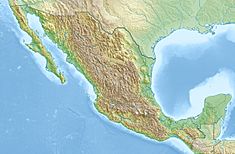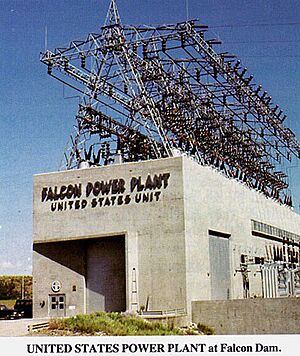Falcon Dam facts for kids
Quick facts for kids Falcon Dam |
|
|---|---|

Falcon Dam
|
|
|
Location of Falcon Dam in Mexico
|
|
| Location | Starr County, Texas, USA / Guerrero Municipality, Tamaulipas, Mexico |
| Coordinates | 26°33′32″N 99°09′53″W / 26.55889°N 99.16472°W |
| Construction began | 1950 |
| Opening date | 1954 |
| Construction cost | $35 million (U.S. Share) |
| Dam and spillways | |
| Impounds | Rio Grande |
| Height | 150 ft (46 m) |
| Length | 26,294 ft (8,014 m) |
| Width (base) | 35 ft (11 m) (Crest) |
| Reservoir | |
| Creates | Falcon International Reservoir |
| Total capacity | 2,645,646 acre⋅ft (3.263356×109 m3) |
| Surface area | 87,400 acres (354 km2) |
| Power station | |
| Turbines | 6 x 10.5 MW Francis |
| Installed capacity | 63 MW |
The Falcon Dam (also known as Presa Falcón in Spanish) is a very large dam built on the Rio Grande river. This river forms part of the border between the United States and Mexico. The dam connects Starr County in Texas, USA, with the city of Nueva Ciudad Guerrero in Tamaulipas, Mexico.
The Falcon Dam is an important structure. It helps save water, provides water for farms (called irrigation), and creates electricity using water power (called hydroelectricity). It also helps control floods and offers places for fun activities like fishing. The dam even serves as an international border crossing point. Building the dam started in December 1950 and finished in April 1954. However, it was officially opened by the presidents of Mexico and the U.S. in October 1953.
Contents
Building the Dam
The idea for the Falcon Dam came from a special agreement. This agreement was called the "Water Treaty of 1944." It was signed between Mexico and the United States. This treaty decided how the two countries would share the water from rivers like the Rio Grande.
Work on the dam began on December 15, 1950. The huge lake behind the dam, called the reservoir, started to fill up with water on August 25, 1953. The dam was officially opened on October 19, 1953. All the construction work was fully finished by April 8, 1954. By October 1954, the power station at the dam began making electricity.
What the Dam is Like
The Falcon Dam is an embankment dam. This means it's made mostly of earth and rock, like a big hill. It stands about 150 ft (46 m) tall and stretches for about 26,294 ft (8,014 m) long. That's over 5 miles!
The dam is built with a lot of materials. It used about 12,600,000 cu yd (9,633,391 m3) of earth-fill. It also has 282,000 cu yd (215,604 m3) of concrete and 10,300 short tons (9,344 t) of strong steel.
In the middle of the dam, there's a special part called a spillway. This is like a giant drain for the lake. It's 1,300 ft (396 m) long. The spillway has six large gates that can open to let water out. These gates help control the water level in the lake and prevent floods.
Power Plants
The Falcon Dam has two hydroelectric power plants. One is on the Mexican side of the border, and the other is on the U.S. side. Each power plant has three large machines called Francis turbine generators. Each generator can make 10.5 MW of electricity. Together, both power plants can make a total of 63 MW of power.
Water from the lake flows through large pipes called penstocks to reach these generators. Each power plant has four penstocks, which are about 13 ft (4 m) wide. The two extra penstocks are there in case more generators are needed in the future.
Falcon International Reservoir
The dam created a huge lake called the Falcon International Reservoir. This lake can hold a lot of water, about 2,645,646 acre⋅ft (3.263356×109 m3). Its surface covers an area of about 87,400 acres (354 km2). This makes it a very important source of water for the region.
Border Crossing
The Falcon Dam also serves as a port of entry between the United States and Mexico. This means it's a place where people and goods can officially cross the border.
Before the dam was built, there was another border crossing in a town called Zapata, Texas. This crossing was on a bridge. When the dam was finished and the lake filled up, the old town of Zapata and its bridge ended up underwater. So, the town of Zapata had to be moved to higher ground. The Falcon Dam then became the new border crossing point.
See also
 In Spanish: Presa Falcón para niños
In Spanish: Presa Falcón para niños



